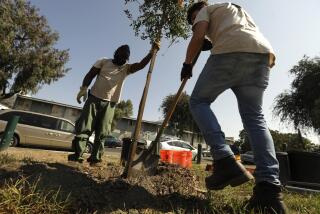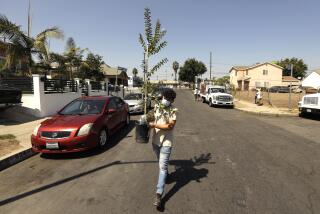Innocent root or strangler?
- Share via
This summer’s hotter-than-usual weather is creating a problem for some unsuspecting homeowners: tree roots clogging sewers.
“In general, heat causes plants to grow faster. Faster-growing plants mean faster-growing roots. This increases the chance that the roots will damage things, including sewer lines,” said Frank McDonough, a botanical information consultant with the L.A. County Arboretum and Botanic Garden, who also hosts the cable television show “Gardens of California.”
Slow-flowing drains, gurgling toilets that won’t flush and backed-up sinks indicate an imminent sewer blockage, according to the Los Angeles Department of Public Works, which maintains more than 6,700 miles of sewer pipes. It’s a mess that arises when trees and sewer lines share space.
“Bigger tree, more roots. More roots, larger chance of the roots entering cracks in the sewer line,” McDonough said. Older tile sewer lines have rubber grommets that rot, he added, enabling roots to pass through joints and into pipes.
The closer a tree is to the sewer line, the more likely it will cause a clog, he said. But trees don’t have to be on top of sewer pipes to cause a problem. Roots generally extend up to 2 1/2 times the height of the tree, although some species have roots that extend five to seven times the height of the tree, according to www.lacity.org/boss/streettree/sewerlines.htm, a city public works website.
Dry weather also can increase the frequency of clogs.
“Roots traditionally look for any drops of moisture. Very small roots will try to invade the pipe. They grow larger, and they will actually damage and break the pipe,” said Barry Berggren, division manager for the city’s wastewater collection system.
“After the heavy El Nino rains, we didn’t see a lot of root problems,” said Nick Arhontes, director of the Regional Assets and Services Department for the Orange County Sanitation District, which maintains 650 miles of sewer lines. “Our theory was trees were getting a lot of ground water from upper soils.”
Some trees are worse offenders than others. Arhontes recommended planting “sewer-friendly” types such as palm trees with shallow roots. Based on staff recommendations and research, the district has identified “better trees” as crepe myrtle, boronia, myrtle wattle, coast banksia, prickly Moses, daisy bush, small crowea, grevillea, heath and westringia.
Ficus trees, Arhontes said, are “very troublesome to sewers.” Other problem trees include jacaranda, bottlebrush, pines, Brazilian peppers, Lombardy poplar, elm, ivy, ash, birch, willows and magnolias.
Those trees are rarely found on median strips, where a house’s sewer line generally connects with the public line. They’re usually in the yard or alongside the house, which gives them proximity to the homeowner’s portion of sewer pipe.
“The issue of roots into sewers is particularly troublesome in ... the laterals -- the portion of the sewer system that is outside of the home and extends from the house to the public sewer line,” said Allan Rigg, public works director and city engineer for Palos Verdes Estates, which maintains 80 miles of pipes.
Inspect regularly
Tree roots need to grow only two or three feet deep to get near laterals buried on private property. In the street, sewer pipes are often buried 6 feet deep. Laterals also clog easier because they are typically 4 inches in diameter while public pipes are generally 8 inches or larger.
Even though lateral pipe “usually extends past the property line,” said Ken Pellman, a spokesman for the county Department of Public Works, it is the homeowner’s responsibility. The agency maintains 5,200 miles of sewer lines in unincorporated areas of the county and 42 cities that contract for services.
If a homeowner reports a problem, a government agency will inspect public pipes. If that line is clear and flowing, the clog is in the lateral. That’s a private matter, and time to call a plumber or a sewer cleaning service.
A web of roots typically causes the problem, said David L. Whyte of Northridge-based Whyte Plumbing Inc., which is also known as Pipe Doctor USA. His crews attack the blockage with a snake that pokes a hole in the roots and debris. That may be followed by a hydrojetter that directs a highly pressurized stream of water through the pipe to clean out the line.
“We clear the roots out to see problems,” he said, explaining that crews also use a color video camera to inspect the line and identify cracks or separations at the joints in the pipes. “If we come to a joint where we didn’t get all the roots out, we back up the camera” and, he said, aim the hydrojetter at the problem.
Within two hours of a cleaning, the crews do a foaming herbicide treatment to keep the roots from growing back. Repairs may require digging up the pipe and replacing a section or placing a liner inside the pipe.
Chronic clogs could require the removal of one or more trees. In most cases, regular maintenance is a major deterrent. Don’t wait until another backup occurs, experts said; schedule regular inspections, one at least every five years if there have been no problems and as frequently as every six months for sewer lines with a history of blockages.
“Just like any other system, whether it be a mechanical system like an oven or a forced-air unit, they do need maintenance,” said Rigg of Palos Verdes Estates. “They can fail, and it can be ugly.”
Prospective buyers concerned about a home’s sewer lines should have the lateral inspected by a trained plumber or sewer contractor before the deal is closed. Because the lines are underground, a regular house inspector would miss the potential for clogs, said Mallory Anderson of the National Assn. of Home Inspectors. “He or she would literally have to be a swami to state that the sewer is going to back up because of tree roots.”
gayle.pollard-terry@latimes .com






